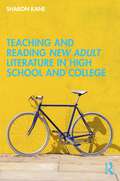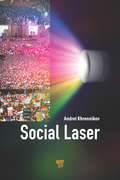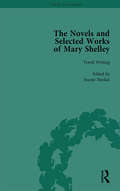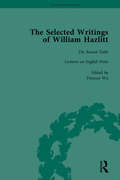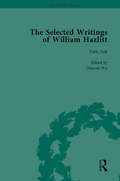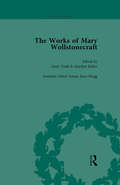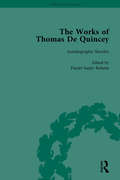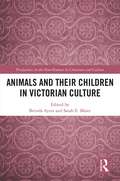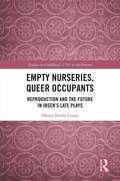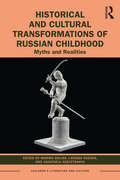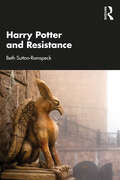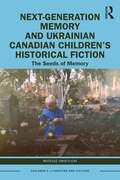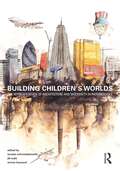- Table View
- List View
Teaching and Reading New Adult Literature in High School and College
by Sharon KaneAn introduction to the rapidly growing category of New Adult (NA) literature, this text provides a roadmap to understanding and introducing NA books to young people in high school, college, libraries, and other settings. As a window into the experiences and unique challenges that young and new adults encounter, New Adult literature intersects with but is distinct from Young Adult literature. This rich resource provides a framework, methods, and plentiful reading recommendations by genre, theme, and discipline on New Adult literature. Starting with a definition of New Adult literature, Kane demonstrates how the inclusion of NA literature helps support and encourage a love of reading. Chapters address important topics that are relevant to young people, including post-high school life, early careers, relationships, activism, and social change. Each chapter features text sets, instructional strategies, writing prompts, and activities to invite and encourage young people to be reflective and engaged in responding to thought-provoking texts. A welcome text for professors of literacy and literature instruction, first-year college instructors, researchers, librarians, and educators, this book provides new ways to assist students as they embark upon the next stage of their lives and is essential reading for courses on teaching literature.
Social Laser: Application of Quantum Information and Field Theories to Modeling of Social Processes
by Andrei KhrennikovThe recent years have been characterized by stormy social protests throughout the world. These protests have some commonalities, but at the same time, their sociopolitical, psychological, and economic contexts differ essentially. An important class of such protests is known as color revolutions. The analysis of these events in social and political literature is characterized by huge diversity of opinions. We remark that the sociopolitical perturbations under consideration are characterized by the cascade dynamics leading to the exponential amplification of coherent social actions. In quantum physics, such exponential and coherent amplification is the basic feature of laser’s functioning. (“Laser” is acronym for light amplification by stimulated emission of radiation). In this book we explore the theory of laser to model aforementioned waves of social protests, from color revolutions to Brexit and Trump’s election. We call such social processes Stimulated Amplification of Social Actions (SASA), but to keep closer to the analogy with physics we merely operate with the term “social laser.”
Social Laser: Application of Quantum Information and Field Theories to Modeling of Social Processes
by Andrei KhrennikovThe recent years have been characterized by stormy social protests throughout the world. These protests have some commonalities, but at the same time, their sociopolitical, psychological, and economic contexts differ essentially. An important class of such protests is known as color revolutions. The analysis of these events in social and political literature is characterized by huge diversity of opinions. We remark that the sociopolitical perturbations under consideration are characterized by the cascade dynamics leading to the exponential amplification of coherent social actions. In quantum physics, such exponential and coherent amplification is the basic feature of laser’s functioning. (“Laser” is acronym for light amplification by stimulated emission of radiation). In this book we explore the theory of laser to model aforementioned waves of social protests, from color revolutions to Brexit and Trump’s election. We call such social processes Stimulated Amplification of Social Actions (SASA), but to keep closer to the analogy with physics we merely operate with the term “social laser.”
The Novels and Selected Works of Mary Shelley Vol 8
by Nora Crook Pamela Clemit Betty T BennettThese eight volumes contain the works of Mary Shelley and include introductions and prefatory notes to each volume. Included in this edition are "Frankenstein" (1818), "Matilda" ((1819), "Valperga" (1823), "The Last Man" (1826), "Perkin Warbeck" (1830) and "Lodore" (1835).
The Selected Writings of William Hazlitt Vol 2
by Duncan Wu Tom Paulin David Bromwich Stanley Jones Roy ParkWilliam Hazlitt is viewed by many as one of the most distinguished of the non-fiction prose writers to emerge from the Romantic period. This nine-volume edition collects all his major works in complete form.
The Selected Writings of William Hazlitt Vol 6
by Duncan Wu Tom Paulin David Bromwich Stanley Jones Roy ParkWilliam Hazlitt is viewed by many as one of the most distinguished of the non-fiction prose writers to emerge from the Romantic period. This nine-volume edition collects all his major works in complete form.
The Works of Mary Wollstonecraft Vol 1
by Marilyn Butler Janet ToddA seven volume set of books containing all the known published writings and translations of Mary Wollstonecraft, who is generally recognised as the mother of the feminist movement. She was also an acute observer of the political upheavals of the French revolution and advocated educational reform.
The Works of Thomas De Quincey, Part III vol 19
by Grevel Lindop Barry SymondsThomas De Quincey (1785-1859) is considered one of the most important English prose writers of the early-19th century. This is the final part of a 21-volume set presenting De Quincey's work, also including previously unpublished material.
The Novels and Selected Works of Mary Shelley Vol 8
by Nora Crook Pamela Clemit Betty T BennettThese eight volumes contain the works of Mary Shelley and include introductions and prefatory notes to each volume. Included in this edition are "Frankenstein" (1818), "Matilda" ((1819), "Valperga" (1823), "The Last Man" (1826), "Perkin Warbeck" (1830) and "Lodore" (1835).
The Selected Writings of William Hazlitt Vol 2
by Duncan Wu Tom Paulin David Bromwich Stanley Jones Roy ParkWilliam Hazlitt is viewed by many as one of the most distinguished of the non-fiction prose writers to emerge from the Romantic period. This nine-volume edition collects all his major works in complete form.
The Selected Writings of William Hazlitt Vol 6
by Duncan Wu Tom Paulin David Bromwich Stanley Jones Roy ParkWilliam Hazlitt is viewed by many as one of the most distinguished of the non-fiction prose writers to emerge from the Romantic period. This nine-volume edition collects all his major works in complete form.
The Works of Mary Wollstonecraft Vol 1
by Marilyn Butler Janet ToddA seven volume set of books containing all the known published writings and translations of Mary Wollstonecraft, who is generally recognised as the mother of the feminist movement. She was also an acute observer of the political upheavals of the French revolution and advocated educational reform.
The Works of Thomas De Quincey, Part III vol 19
by Grevel Lindop Barry SymondsThomas De Quincey (1785-1859) is considered one of the most important English prose writers of the early-19th century. This is the final part of a 21-volume set presenting De Quincey's work, also including previously unpublished material.
Animals and Their Children in Victorian Culture (Perspectives on the Non-Human in Literature and Culture)
by Brenda Ayres Sarah Elizabeth MaierWhether a secularized morality, biblical worldview, or unstated set of mores, the Victorian period can and always will be distinguished from those before and after for its pervasive sense of the "proper way" of thinking, speaking, doing, and acting. Animals in literature taught Victorian children how to be behave. If you are a postmodern posthumanist, you might argue, "But the animals in literature did not write their own accounts." Animal characters may be the creations of writers’ imagination, but animals did and do exist in their own right, as did and do humans. The original essays in Animals and Their Children in Victorian explore the representation of animals in children’s literature by resisting an anthropomorphized perception of them. Instead of focusing on the domestication of animals, this book analyzes how animals in literature "civilize" children, teaching them how to get along with fellow creatures—both human and nonhuman.
Animals and Their Children in Victorian Culture (Perspectives on the Non-Human in Literature and Culture)
by Brenda Ayres Sarah Elizabeth MaierWhether a secularized morality, biblical worldview, or unstated set of mores, the Victorian period can and always will be distinguished from those before and after for its pervasive sense of the "proper way" of thinking, speaking, doing, and acting. Animals in literature taught Victorian children how to be behave. If you are a postmodern posthumanist, you might argue, "But the animals in literature did not write their own accounts." Animal characters may be the creations of writers’ imagination, but animals did and do exist in their own right, as did and do humans. The original essays in Animals and Their Children in Victorian explore the representation of animals in children’s literature by resisting an anthropomorphized perception of them. Instead of focusing on the domestication of animals, this book analyzes how animals in literature "civilize" children, teaching them how to get along with fellow creatures—both human and nonhuman.
Empty Nurseries, Queer Occupants: Reproduction and the Future in Ibsen’s Late Plays (Studies in Childhood, 1700 to the Present)
by Olivia Noble GunnWho is the proper occupant of the nursery? The obvious answer is the child, and not an archive, a seductive troll-princess, or poor fosterlings. Nevertheless, characters in Hedda Gabler, The Master Builder, and Little Eyolf intend to host these improper occupants in their children’s rooms. Dr. Gunn calls these dramas ‘the empty nursery plays’ because they all describe rooms intended for offspring, as well as characters’ plans for refilling that space. One might expect nurseries to provide an ideal setting for a realist playwright to dramatize contemporary problems. Rather than mattering to Ibsen in terms of naturalist detail or explicit social critique, however, they are reserved for the maintenance of characters’ fears and expectations concerning the future. Empty Nurseries, Queer Occupants intervenes in scholarly debates in child studies by arguing that the empty bourgeois nursery is a better symbol for innocence than the child. Here, ‘emptiness’ refers to the common construction of the child as blank and latent. In Ibsen, the child is also doomed or deceased, and thus essentially absent, but nurseries persist as spaces of memorialization and potential alike. Nurseries also gesture toward the domains of childhood and women’s labor, from birth to domestic service. ‘Bourgeois nursery’ points to the classed construction of innocence and to the more materialist aspects of this book, which inform our understanding of domesticity and family in the West and uncover a set of reproductive connotations broader than ‘the innocent child’ can convey.
Empty Nurseries, Queer Occupants: Reproduction and the Future in Ibsen’s Late Plays (Studies in Childhood, 1700 to the Present)
by Olivia Noble GunnWho is the proper occupant of the nursery? The obvious answer is the child, and not an archive, a seductive troll-princess, or poor fosterlings. Nevertheless, characters in Hedda Gabler, The Master Builder, and Little Eyolf intend to host these improper occupants in their children’s rooms. Dr. Gunn calls these dramas ‘the empty nursery plays’ because they all describe rooms intended for offspring, as well as characters’ plans for refilling that space. One might expect nurseries to provide an ideal setting for a realist playwright to dramatize contemporary problems. Rather than mattering to Ibsen in terms of naturalist detail or explicit social critique, however, they are reserved for the maintenance of characters’ fears and expectations concerning the future. Empty Nurseries, Queer Occupants intervenes in scholarly debates in child studies by arguing that the empty bourgeois nursery is a better symbol for innocence than the child. Here, ‘emptiness’ refers to the common construction of the child as blank and latent. In Ibsen, the child is also doomed or deceased, and thus essentially absent, but nurseries persist as spaces of memorialization and potential alike. Nurseries also gesture toward the domains of childhood and women’s labor, from birth to domestic service. ‘Bourgeois nursery’ points to the classed construction of innocence and to the more materialist aspects of this book, which inform our understanding of domesticity and family in the West and uncover a set of reproductive connotations broader than ‘the innocent child’ can convey.
Historical and Cultural Transformations of Russian Childhood: Myths and Realities (Children's Literature and Culture)
by Marina Balina Larissa Rudova Anastasia KostetskayaHistorical and Cultural Transformations of Russian Childhood is a collection of multidisciplinary scholarly essays on childhood experience. The volume offers new critical approaches to Russian and Soviet childhood at the intersection of philosophy, literary criticism, film/visual studies, and history. Pedagogical ideas and practices, and the ideological and political underpinnings of the experience of growing up in pre-revolutionary Russia, the Soviet Union, and Putin’s contemporary Russia are central venues of analysis. Toward the goal of constructing the "multimedial childhood text," the contributors tackle issues of happiness and trauma associated with childhood and foreground its fluidity and instability in the Russian context. The volume further examines practices of reading childhood: as nostalgic text, documentary evidence, and historic mythology. Considering Russian childhood as historical documentation or fictional narrative, as an object of material culture, and as embodied in different media (periodicals, visual culture, and cinema), the volume intends to both problematize but also elucidate the relationship between childhood, history, and various modes of narrativity.
Historical and Cultural Transformations of Russian Childhood: Myths and Realities (Children's Literature and Culture)
by Marina Balina Larissa Rudova Anastasia KostetskayaHistorical and Cultural Transformations of Russian Childhood is a collection of multidisciplinary scholarly essays on childhood experience. The volume offers new critical approaches to Russian and Soviet childhood at the intersection of philosophy, literary criticism, film/visual studies, and history. Pedagogical ideas and practices, and the ideological and political underpinnings of the experience of growing up in pre-revolutionary Russia, the Soviet Union, and Putin’s contemporary Russia are central venues of analysis. Toward the goal of constructing the "multimedial childhood text," the contributors tackle issues of happiness and trauma associated with childhood and foreground its fluidity and instability in the Russian context. The volume further examines practices of reading childhood: as nostalgic text, documentary evidence, and historic mythology. Considering Russian childhood as historical documentation or fictional narrative, as an object of material culture, and as embodied in different media (periodicals, visual culture, and cinema), the volume intends to both problematize but also elucidate the relationship between childhood, history, and various modes of narrativity.
Harry Potter and Resistance
by Beth Sutton-RamspeckAlthough rule breaking in Harry Potter is sometimes dismissed as a distraction from Harry’s fight against Lord Voldemort, Harry Potter and Resistance makes the case that it is central to the battle against evil. Far beyond youthful hijinks or adolescent defiance, Harry’s rebellion aims to overcome problems deeper and more widespread than a single malevolent wizard. Harry and his allies engage in a resistance movement against the corruption of the Ministry of Magic as well as against the racist social norms that gave rise to Voldemort in the first place. Dumbledore’s Army and the Order of the Phoenix employ methods echoing those utilized by World War II resistance fighters and by the U.S. Civil Rights movement. The aim of this book is to explore issues that speak to our era of heightened political awareness and resistance to intolerance. Its interdisciplinary approach draws on political science, psychology, philosophy, history, race studies, and women’s studies, as well as newer interdisciplinary fields such as resistance studies, disgust studies, and creativity studies.
Next-Generation Memory and Ukrainian Canadian Children’s Historical Fiction: The Seeds of Memory (Children's Literature and Culture)
by Mateusz ŚwietlickiThis is the first book monograph devoted to Anglophone Ukrainian Canadian children’s historical fiction published between 1991 and 2021. It consists of five chapters offering cross-sectional and interdisciplinary readings of 41 books – novels, novellas, picturebooks, short stories, and a graphic novel. The first three chapters focus on texts about the complex process of becoming Ukrainian Canadian, showcasing the experiences of the first two waves of Ukrainian immigration to Canada, including encounters with Indigenous Peoples and the First World War Internment. The last two chapters are devoted to the significance of the cultural memory of the Holodomor, the Great Famine of 1932-1933, and the Second World War for Ukrainian Canadians. All the chapters demonstrate the entanglements of Ukrainian and Canadian history and point to the role Anglophone children’s literature can play in preventing the symbolical seeds of memory from withering. This volume argues that reading, imagining, and reimagining history can lead to the formation of beyond-textual next-generation memory. Such memory created through reading is multidimensional as it involves the interpretation of both the present and the past by an individual whose reality has been directly or indirectly shaped by the past over which they have no influence. Next-generation memory is of anticipatory character, which means that authors of historical fiction anticipate the readers – both present-day and future – not to have direct links to any witnesses of the events they discuss and to have little knowledge of the transcultural character of the Ukrainian Canadian diaspora.
Harry Potter and Resistance
by Beth Sutton-RamspeckAlthough rule breaking in Harry Potter is sometimes dismissed as a distraction from Harry’s fight against Lord Voldemort, Harry Potter and Resistance makes the case that it is central to the battle against evil. Far beyond youthful hijinks or adolescent defiance, Harry’s rebellion aims to overcome problems deeper and more widespread than a single malevolent wizard. Harry and his allies engage in a resistance movement against the corruption of the Ministry of Magic as well as against the racist social norms that gave rise to Voldemort in the first place. Dumbledore’s Army and the Order of the Phoenix employ methods echoing those utilized by World War II resistance fighters and by the U.S. Civil Rights movement. The aim of this book is to explore issues that speak to our era of heightened political awareness and resistance to intolerance. Its interdisciplinary approach draws on political science, psychology, philosophy, history, race studies, and women’s studies, as well as newer interdisciplinary fields such as resistance studies, disgust studies, and creativity studies.
Next-Generation Memory and Ukrainian Canadian Children’s Historical Fiction: The Seeds of Memory (Children's Literature and Culture)
by Mateusz ŚwietlickiThis is the first book monograph devoted to Anglophone Ukrainian Canadian children’s historical fiction published between 1991 and 2021. It consists of five chapters offering cross-sectional and interdisciplinary readings of 41 books – novels, novellas, picturebooks, short stories, and a graphic novel. The first three chapters focus on texts about the complex process of becoming Ukrainian Canadian, showcasing the experiences of the first two waves of Ukrainian immigration to Canada, including encounters with Indigenous Peoples and the First World War Internment. The last two chapters are devoted to the significance of the cultural memory of the Holodomor, the Great Famine of 1932-1933, and the Second World War for Ukrainian Canadians. All the chapters demonstrate the entanglements of Ukrainian and Canadian history and point to the role Anglophone children’s literature can play in preventing the symbolical seeds of memory from withering. This volume argues that reading, imagining, and reimagining history can lead to the formation of beyond-textual next-generation memory. Such memory created through reading is multidimensional as it involves the interpretation of both the present and the past by an individual whose reality has been directly or indirectly shaped by the past over which they have no influence. Next-generation memory is of anticipatory character, which means that authors of historical fiction anticipate the readers – both present-day and future – not to have direct links to any witnesses of the events they discuss and to have little knowledge of the transcultural character of the Ukrainian Canadian diaspora.
Building Children’s Worlds: The Representation of Architecture and Modernity in Picturebooks
by Torsten Schmiedeknecht Jill Rudd Emma HaywardChildren are the future architects, clients and users of our buildings. The kinds of architectural worlds they are exposed to in picturebooks during their formative years may be assumed to influence how they regard such architecture as adults. Contemporary urban environments the world over represent the various stages of modernism in architecture. This book reads that history through picturebooks and considers the kinds of national identities and histories they construct. Twelve specialist essays from international scholars address questions such as: Is modern architecture used to construct specific narratives of childhood? Is it taken to support ‘negative’ narratives of alienation on the one hand and ‘positive’ narratives of happiness on the other? Do images of modern architecture support ideas of ‘community’? Reinforce ‘family values’? If so, what kinds of architecture, community and family? How is modern architecture placed vis-à-vis the promotion of diversity (ethnic, religious, gender etc.)? How might the use of architecture in comic strips or the presence of specific kinds of building in fiction aimed at younger adults be related to the groundwork laid in picturebooks for younger readers? This book reveals what stories are told about modern architecture and shows how those stories affect future attitudes towards and expectations of the built environment.
Building Children’s Worlds: The Representation of Architecture and Modernity in Picturebooks
by Torsten Schmiedeknecht Jill Rudd Emma HaywardChildren are the future architects, clients and users of our buildings. The kinds of architectural worlds they are exposed to in picturebooks during their formative years may be assumed to influence how they regard such architecture as adults. Contemporary urban environments the world over represent the various stages of modernism in architecture. This book reads that history through picturebooks and considers the kinds of national identities and histories they construct. Twelve specialist essays from international scholars address questions such as: Is modern architecture used to construct specific narratives of childhood? Is it taken to support ‘negative’ narratives of alienation on the one hand and ‘positive’ narratives of happiness on the other? Do images of modern architecture support ideas of ‘community’? Reinforce ‘family values’? If so, what kinds of architecture, community and family? How is modern architecture placed vis-à-vis the promotion of diversity (ethnic, religious, gender etc.)? How might the use of architecture in comic strips or the presence of specific kinds of building in fiction aimed at younger adults be related to the groundwork laid in picturebooks for younger readers? This book reveals what stories are told about modern architecture and shows how those stories affect future attitudes towards and expectations of the built environment.
